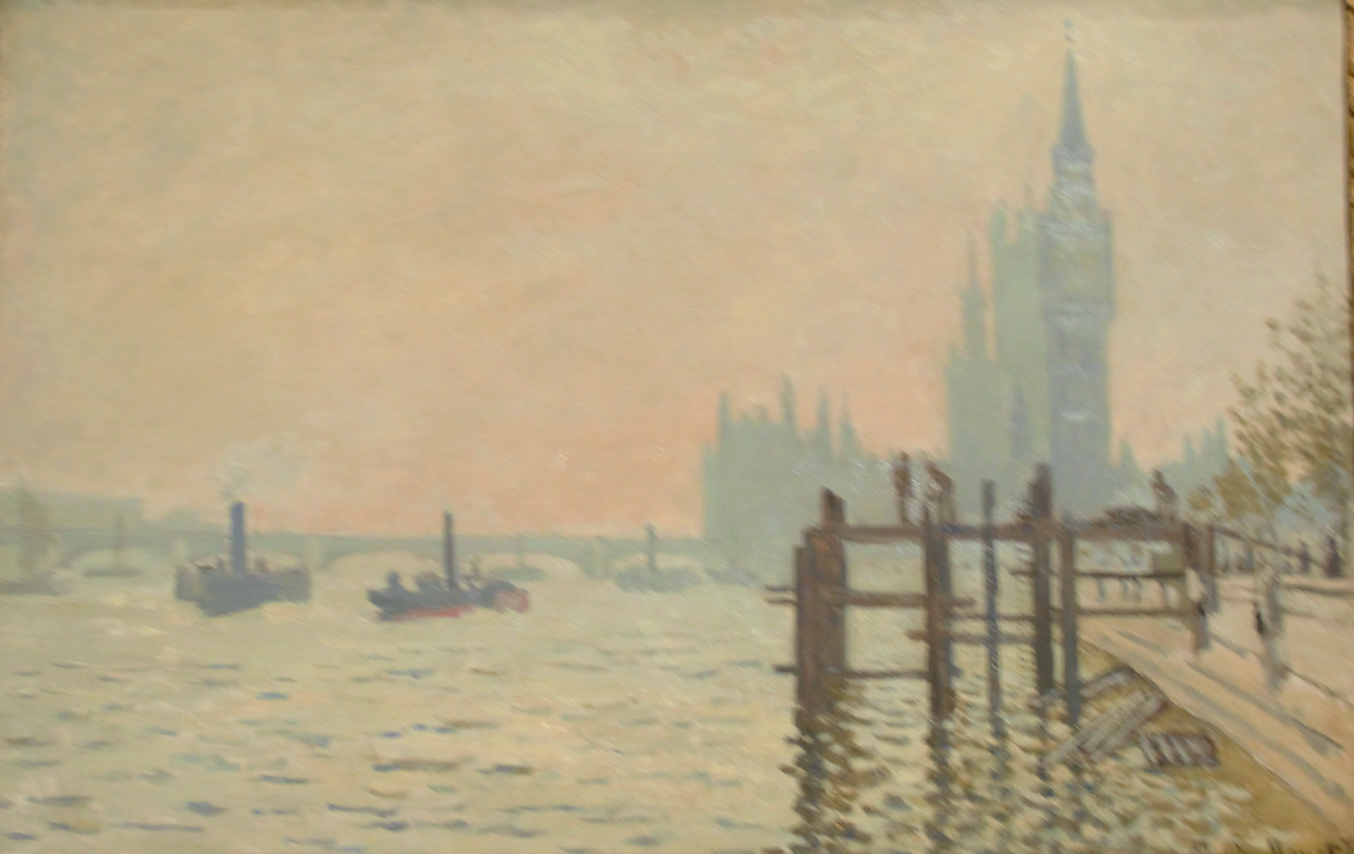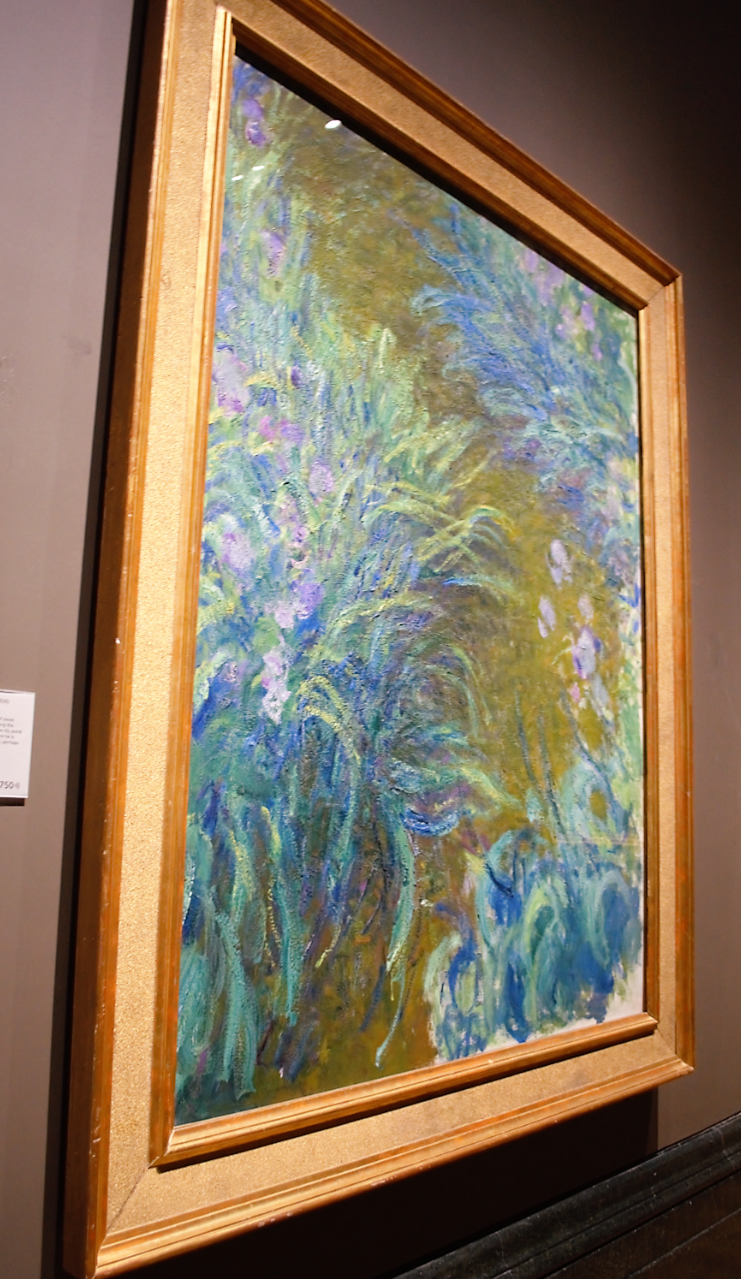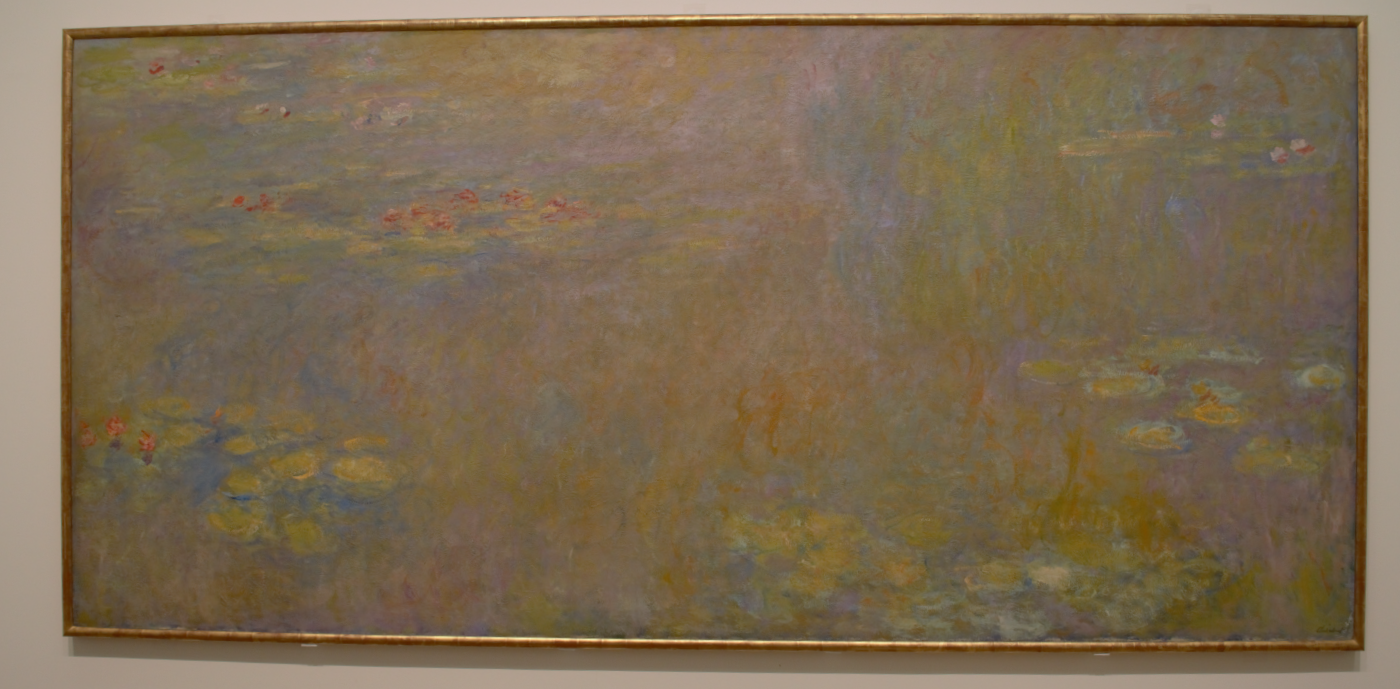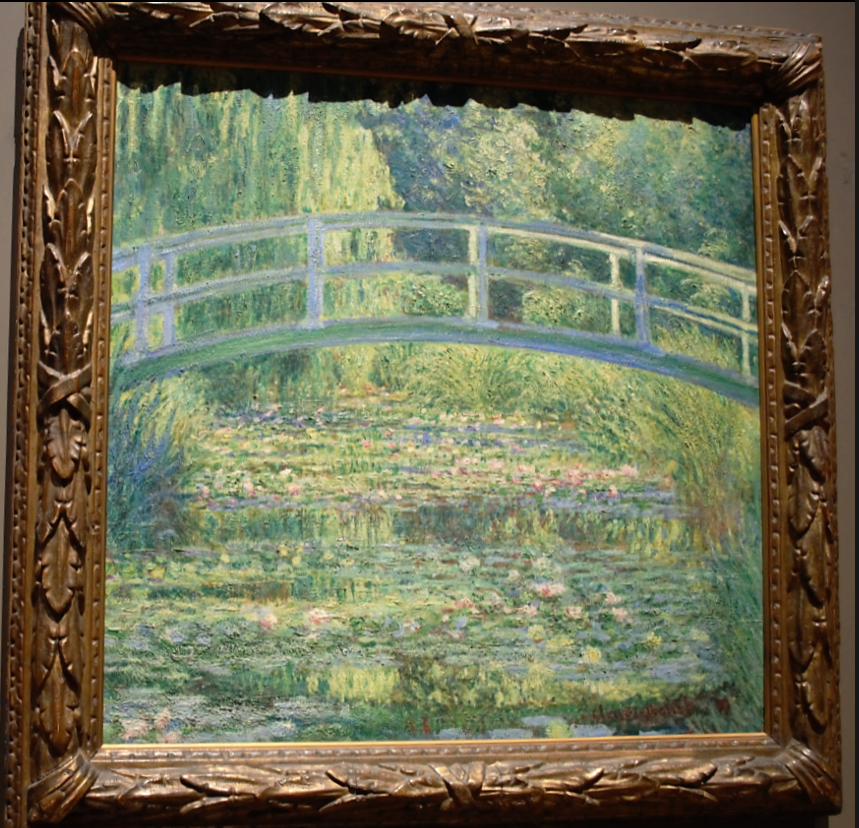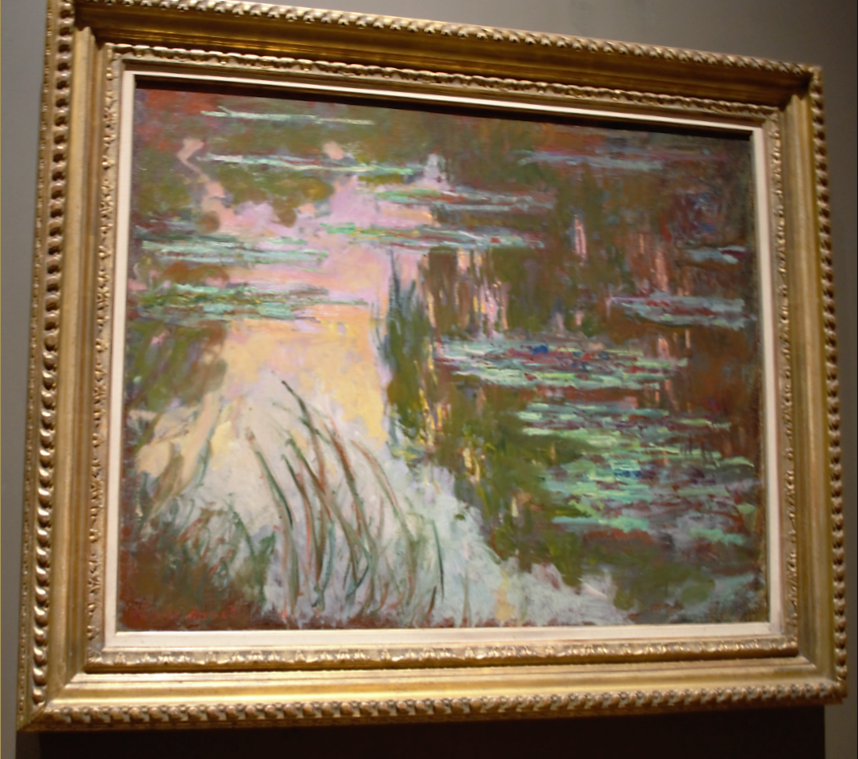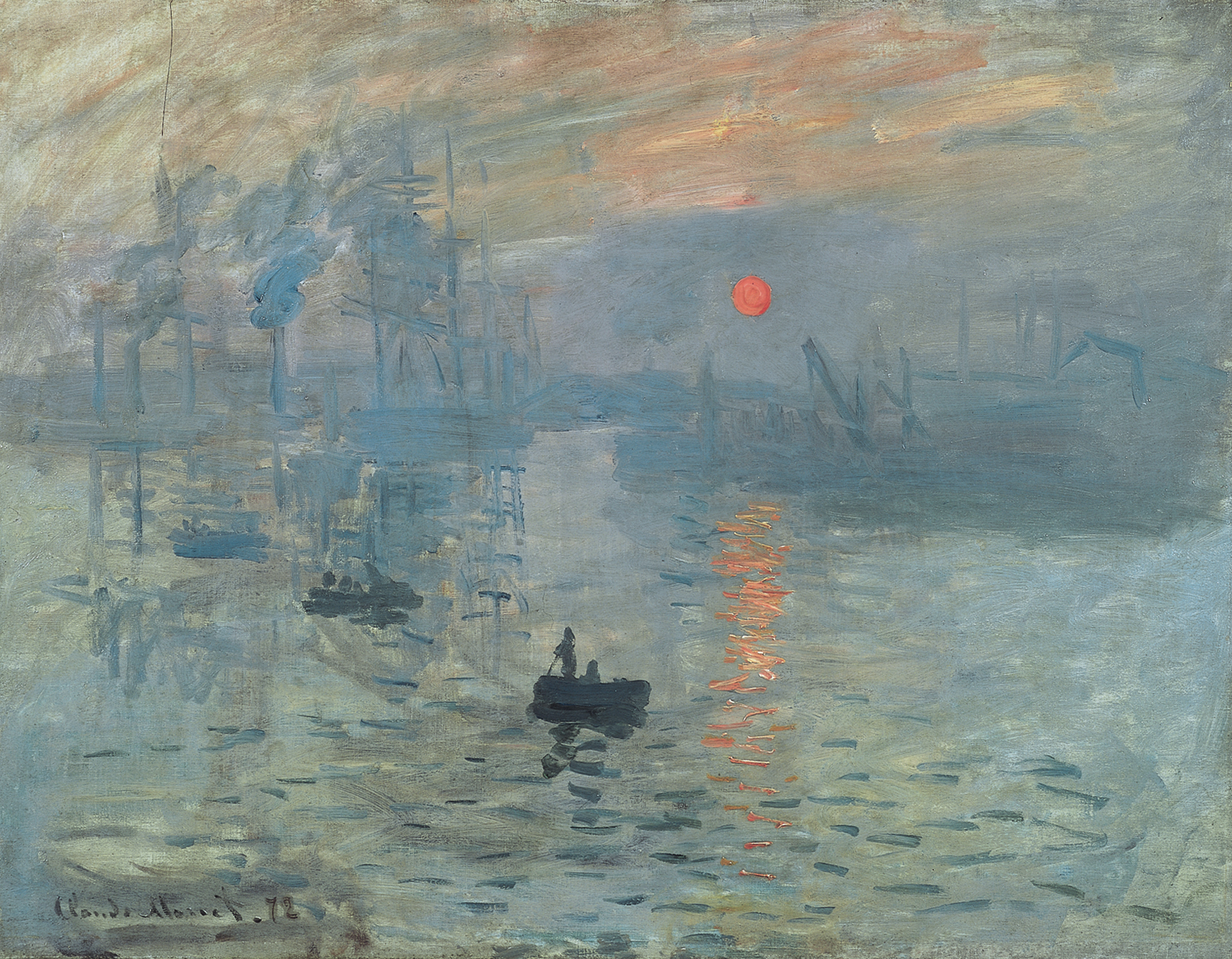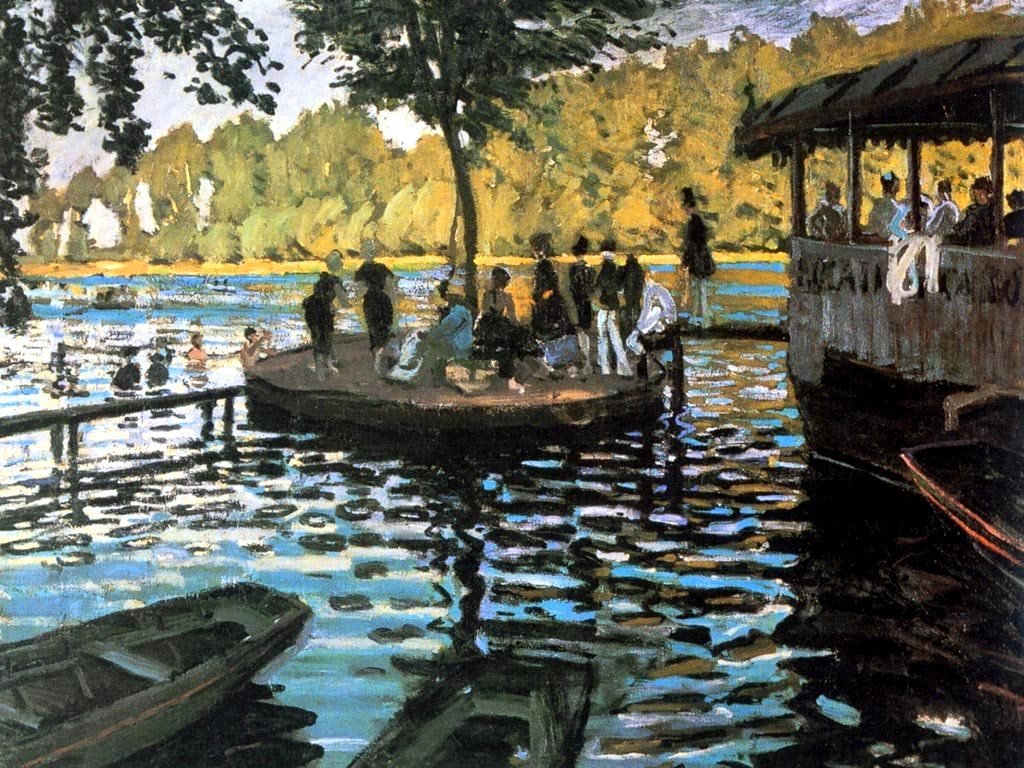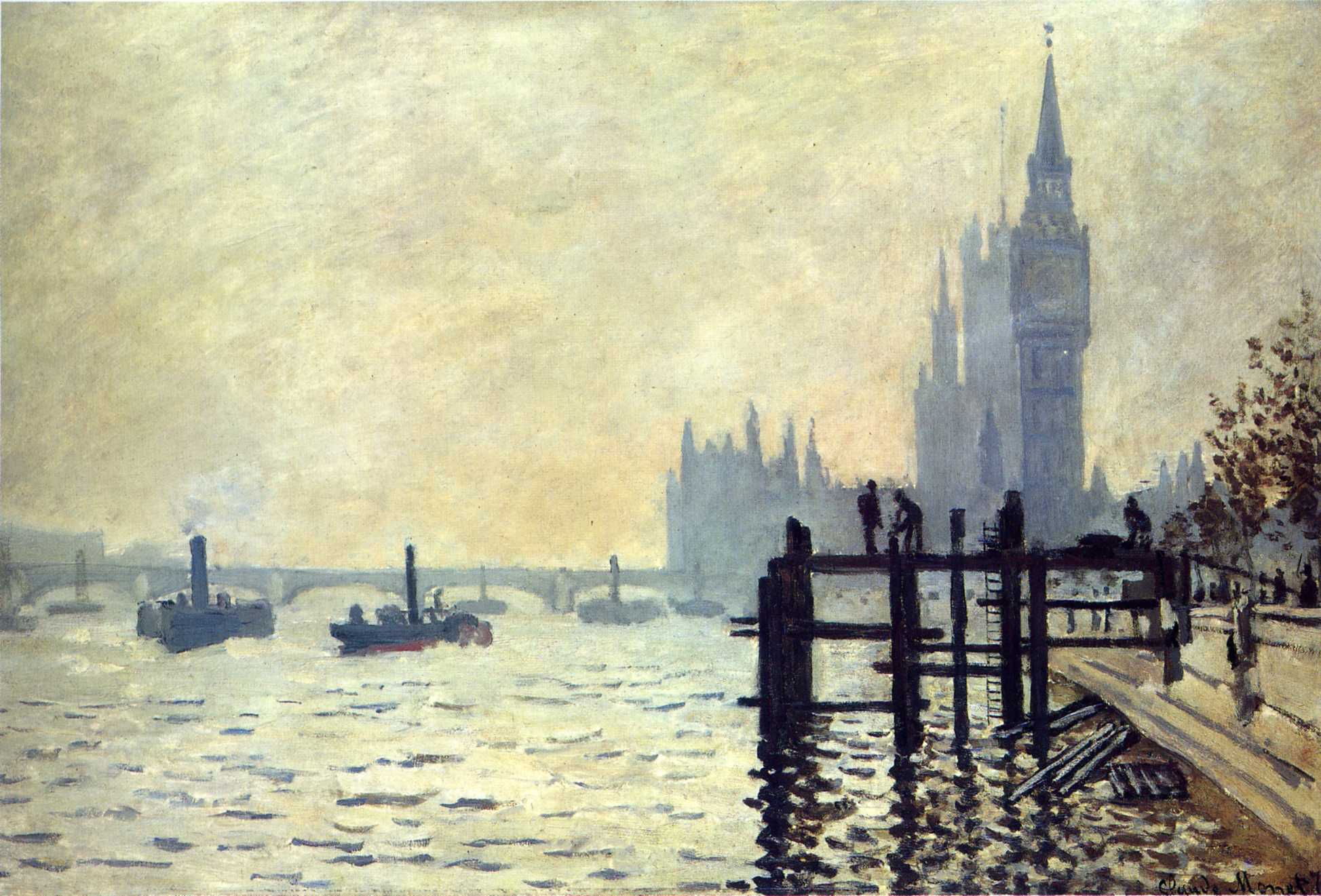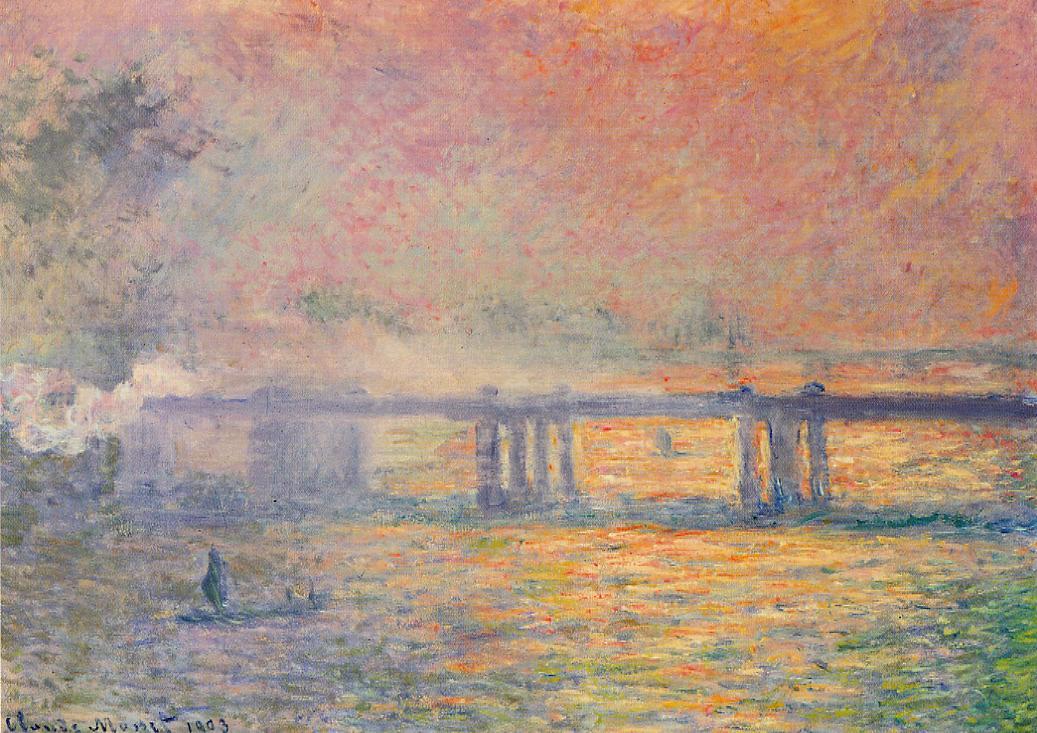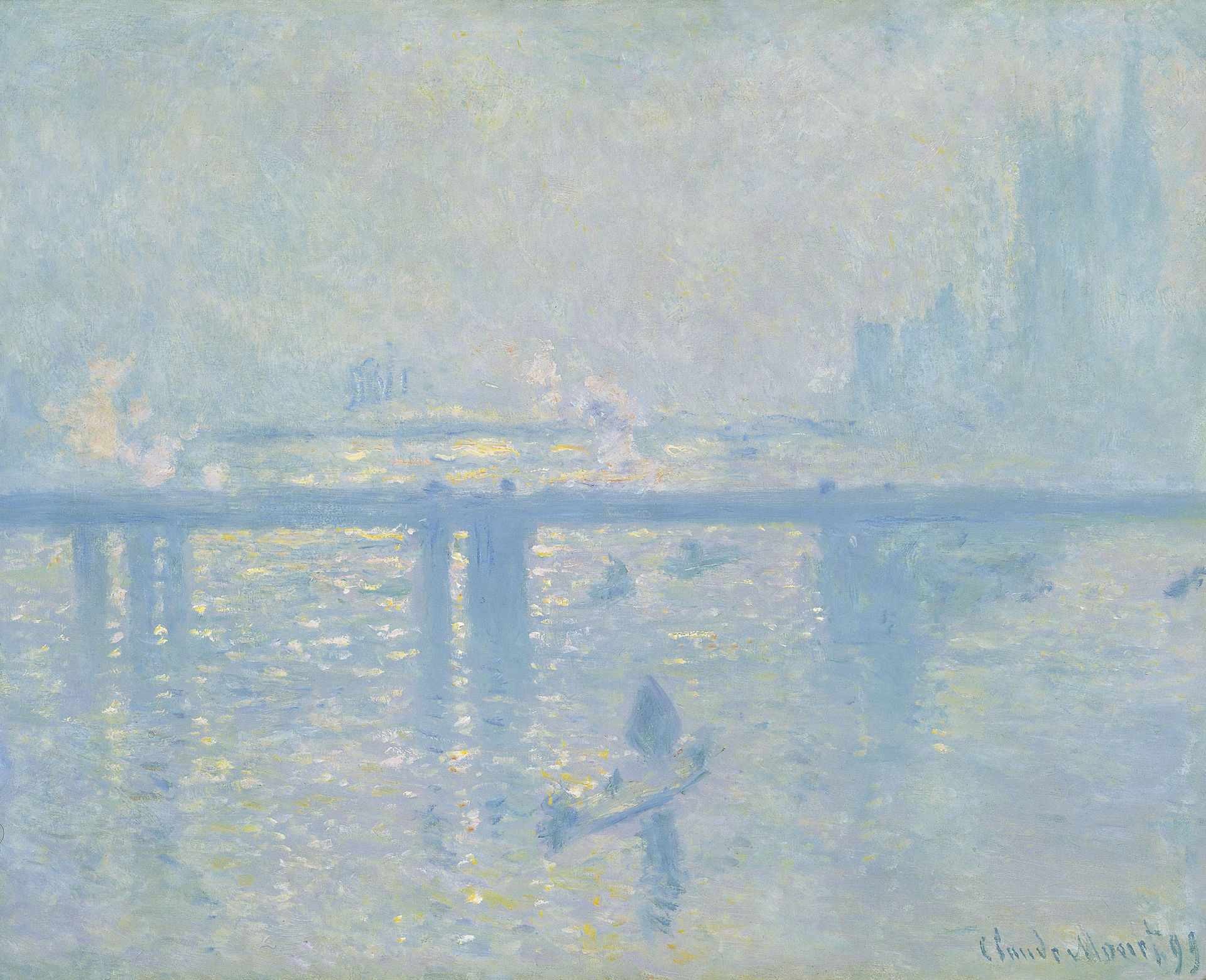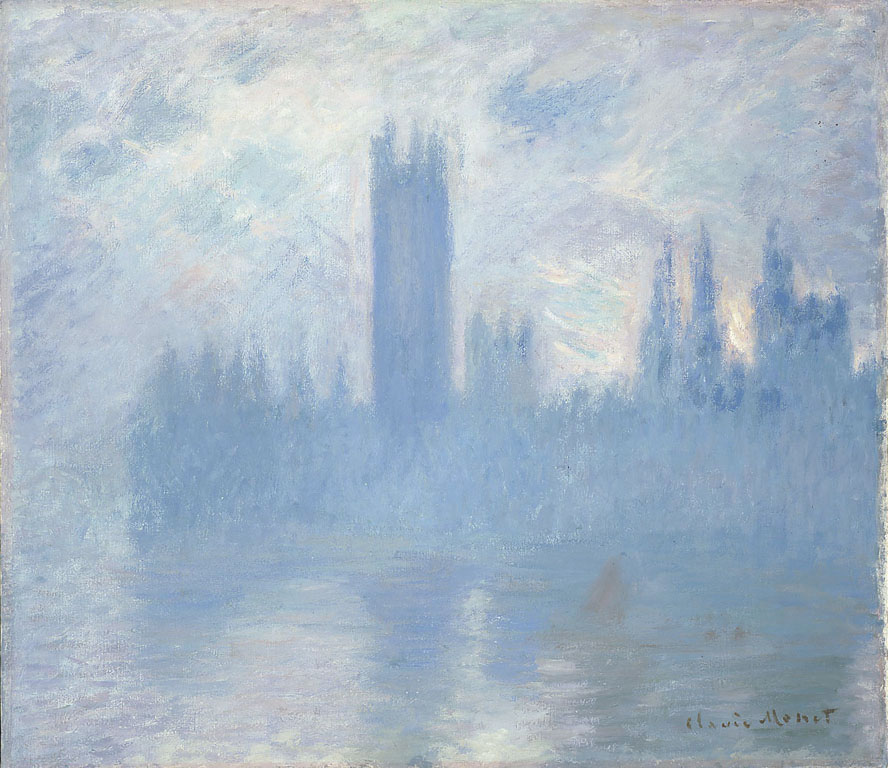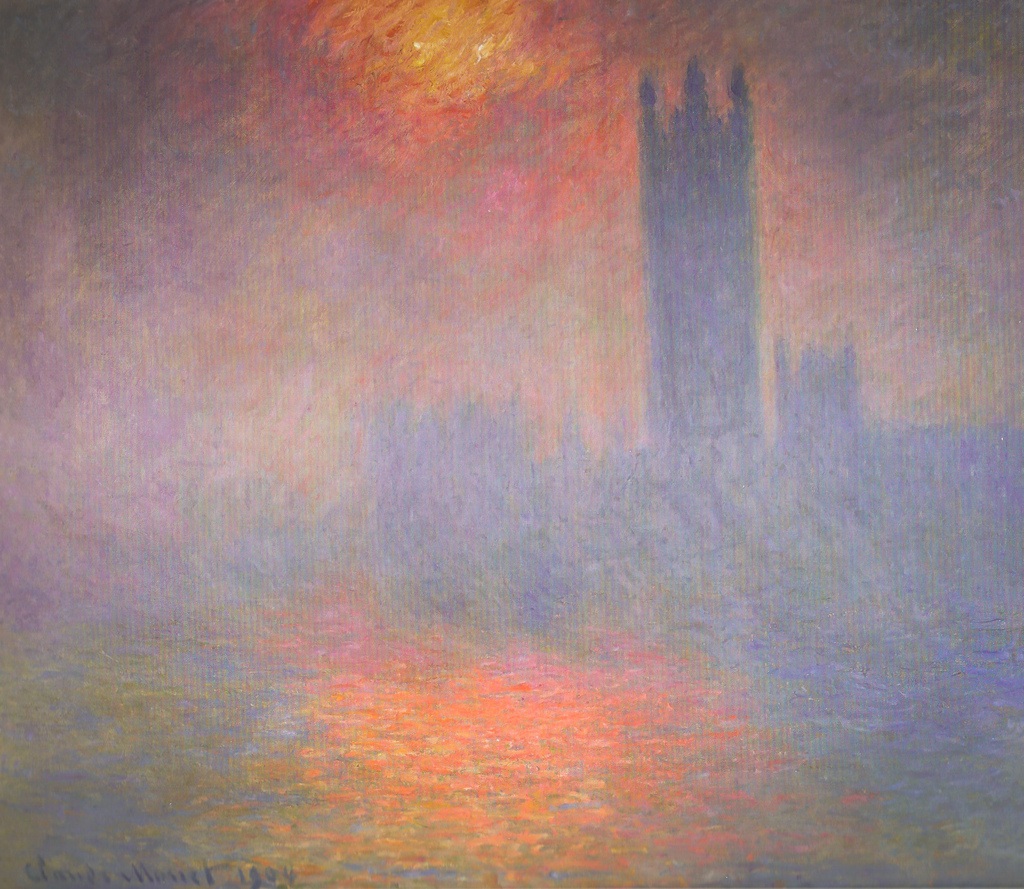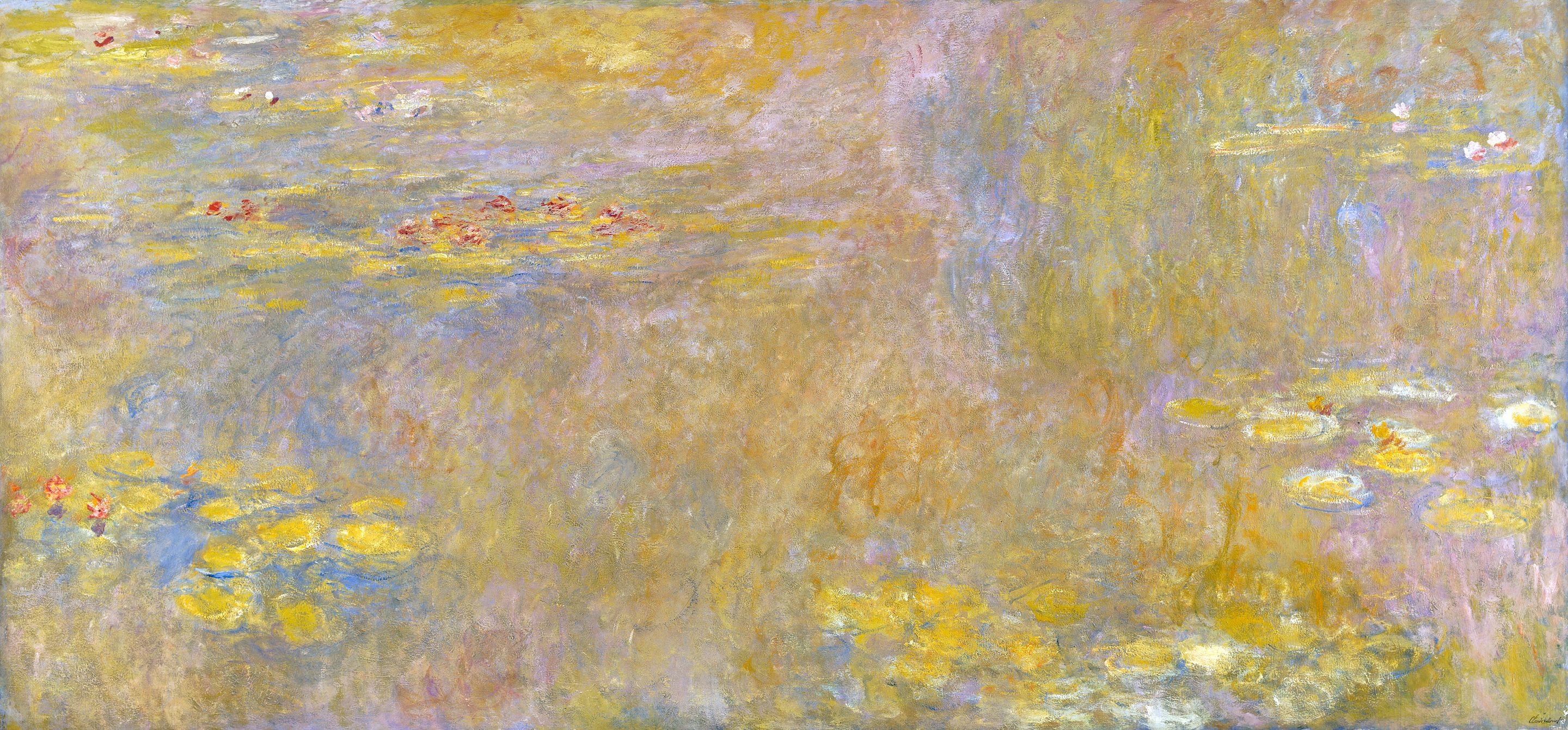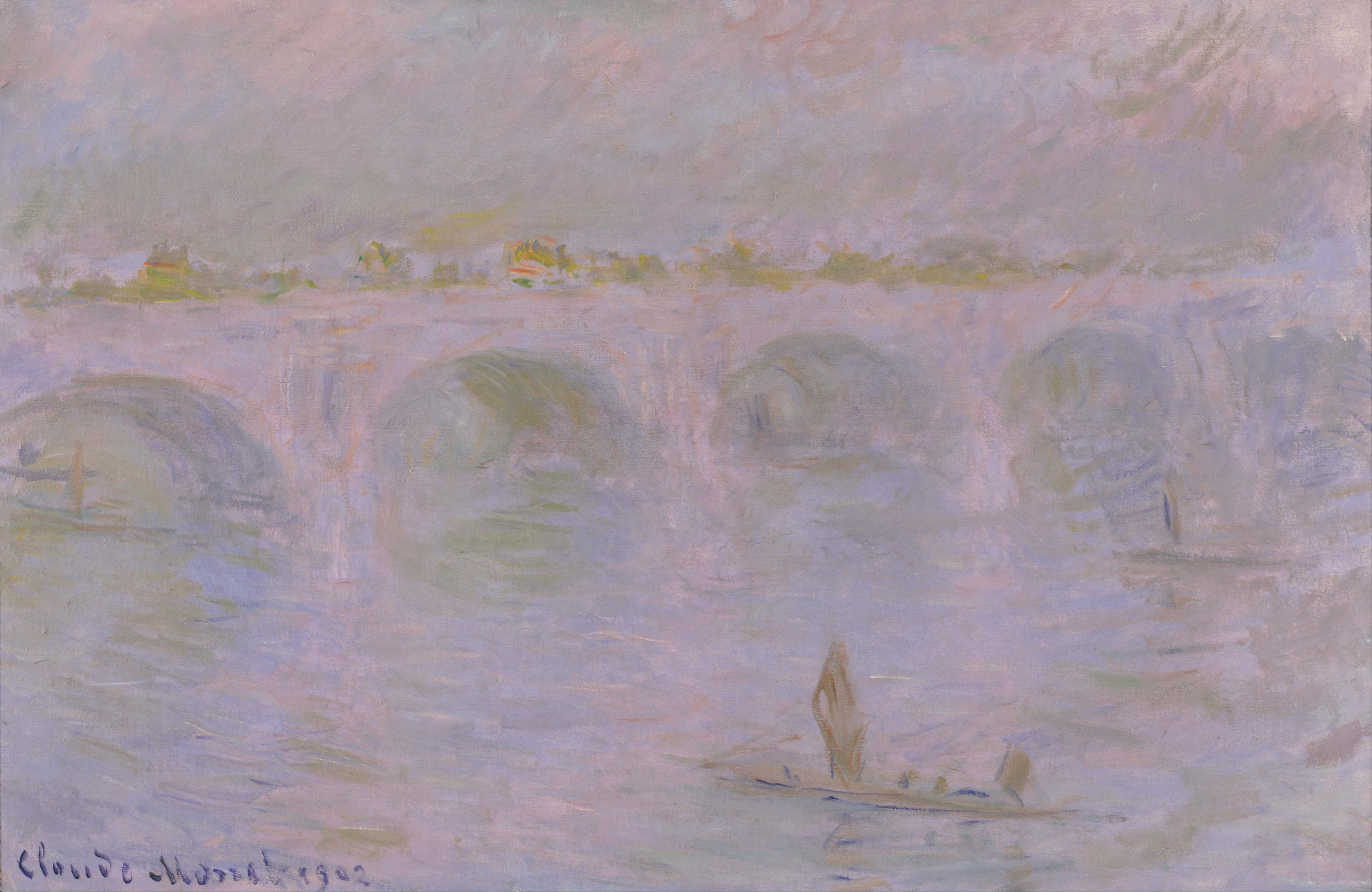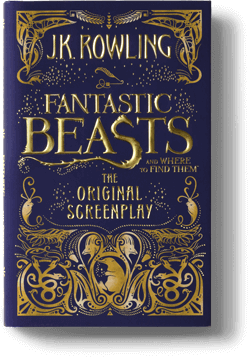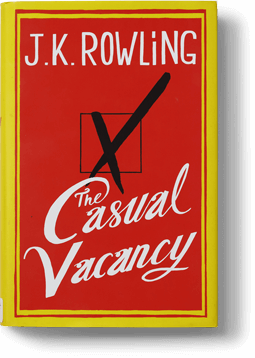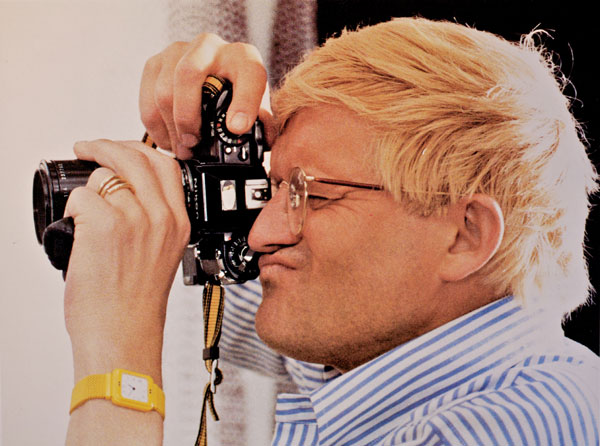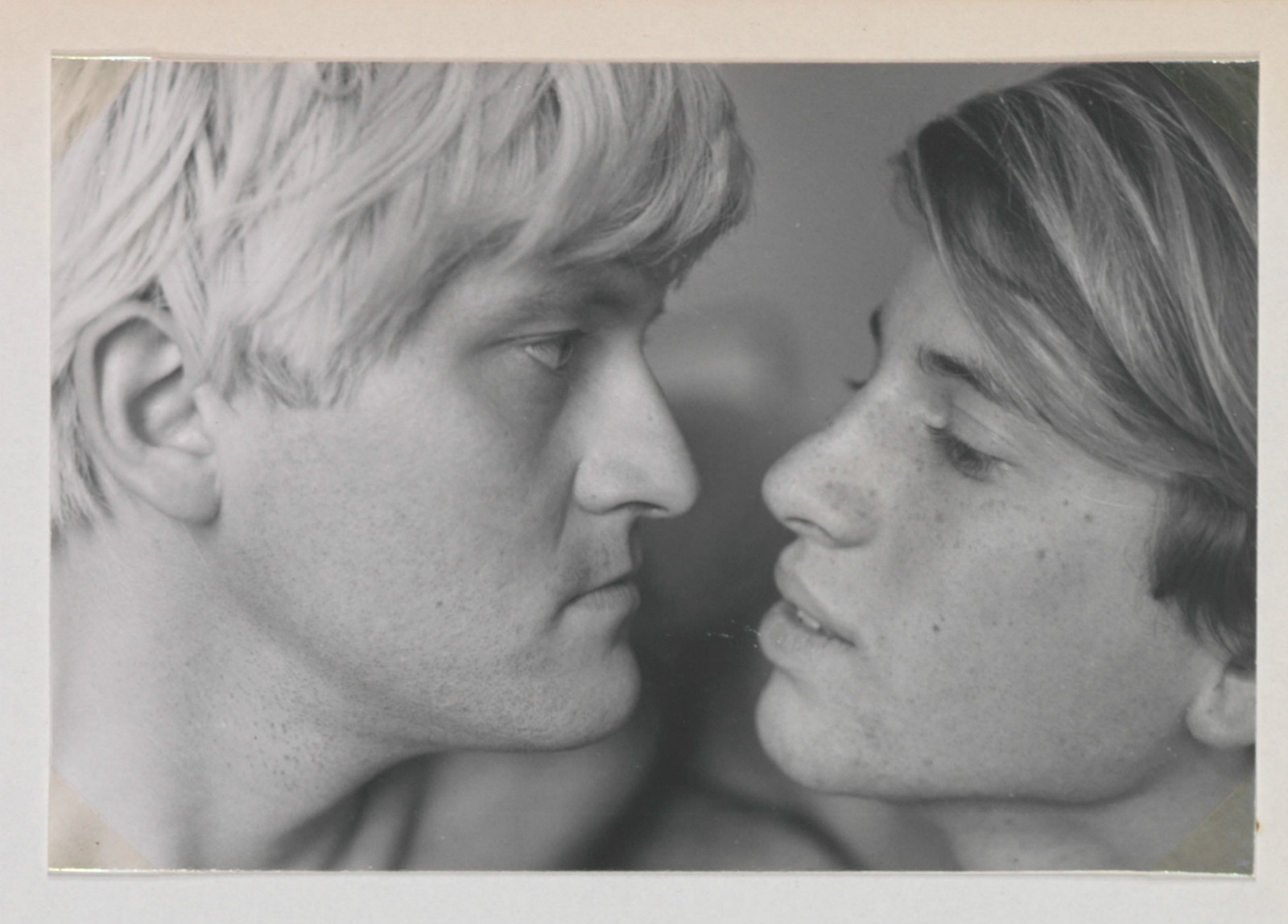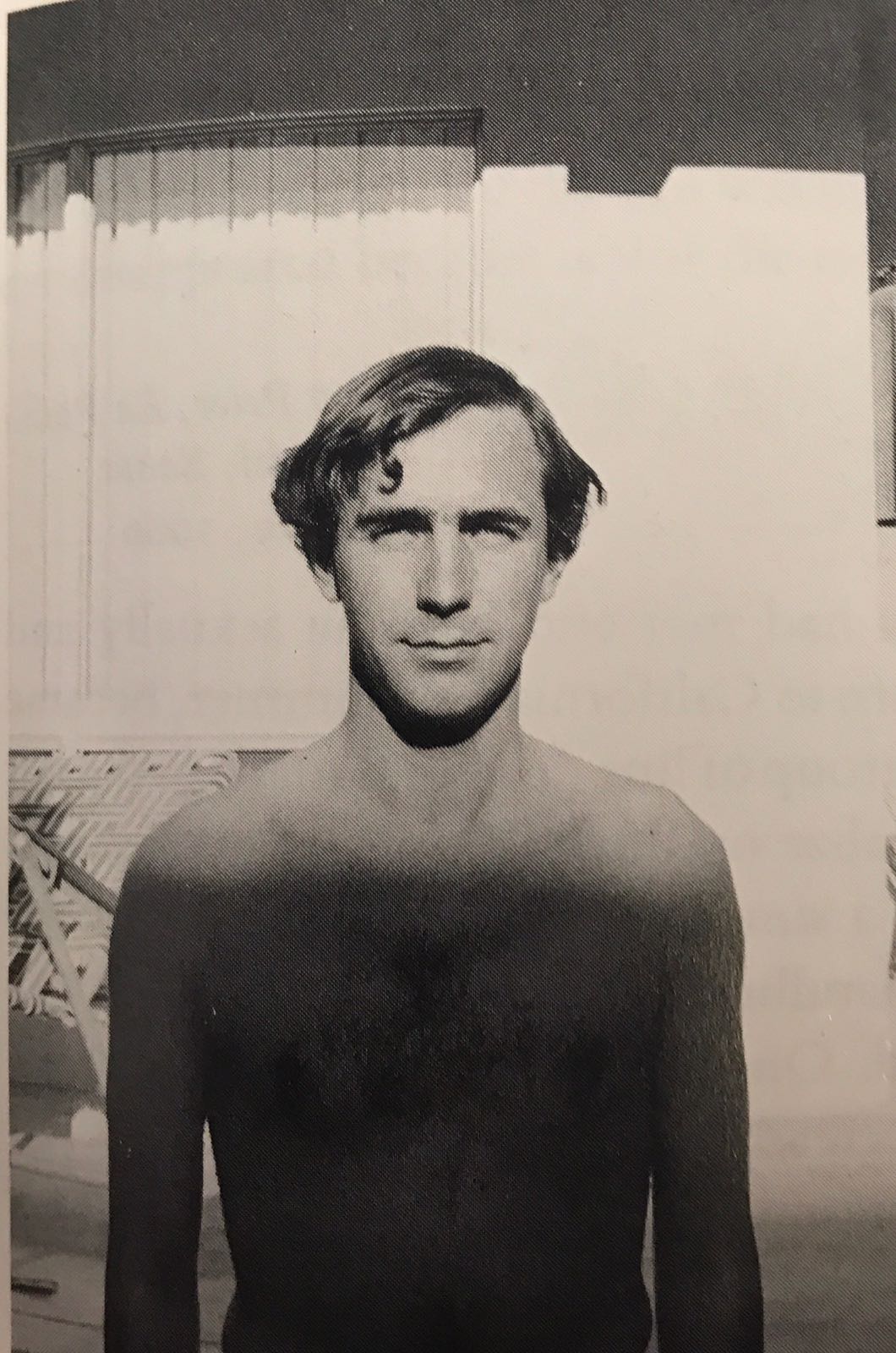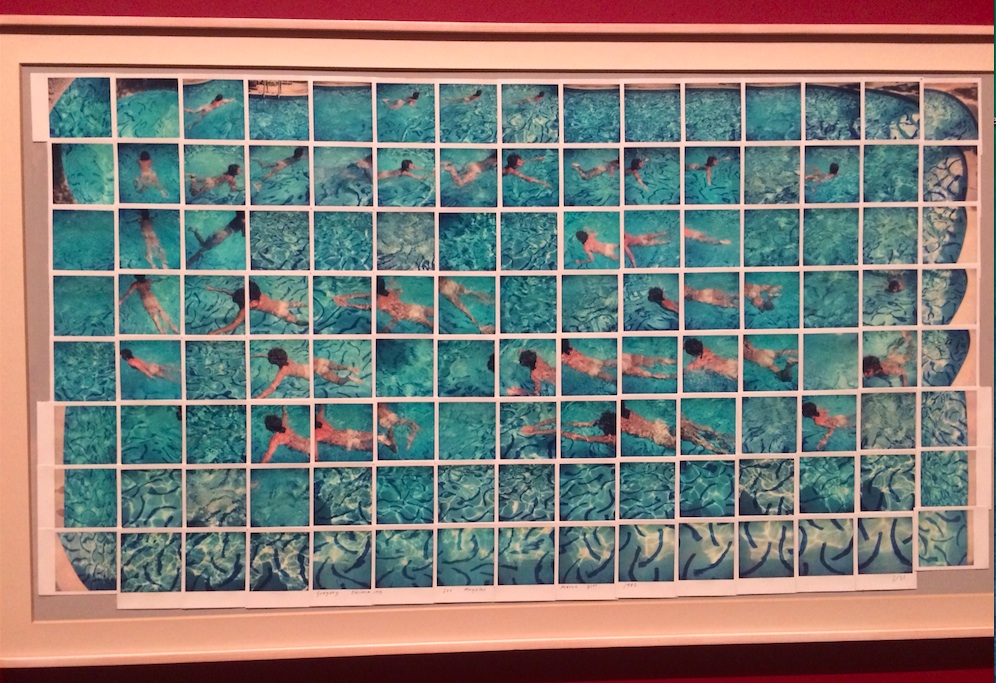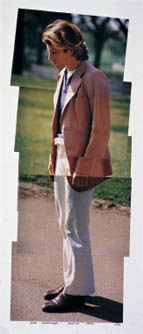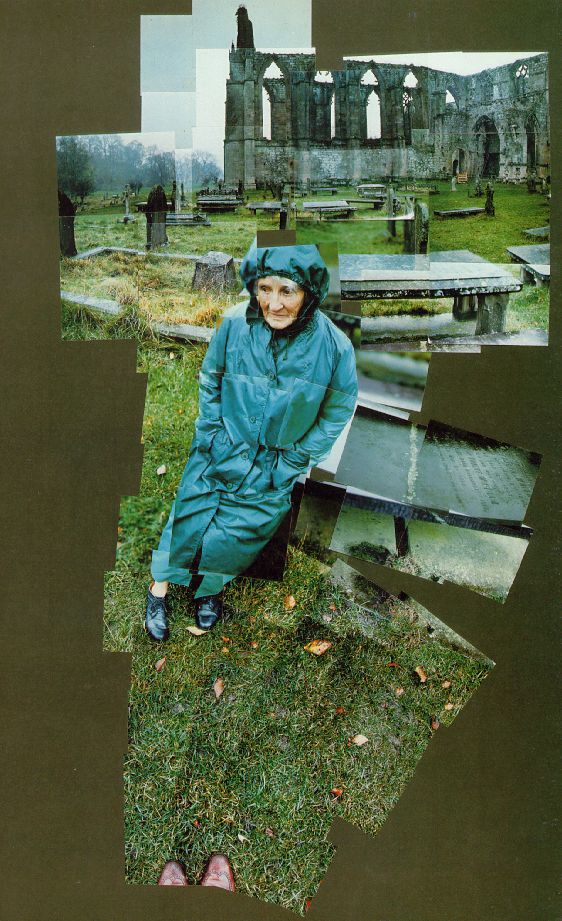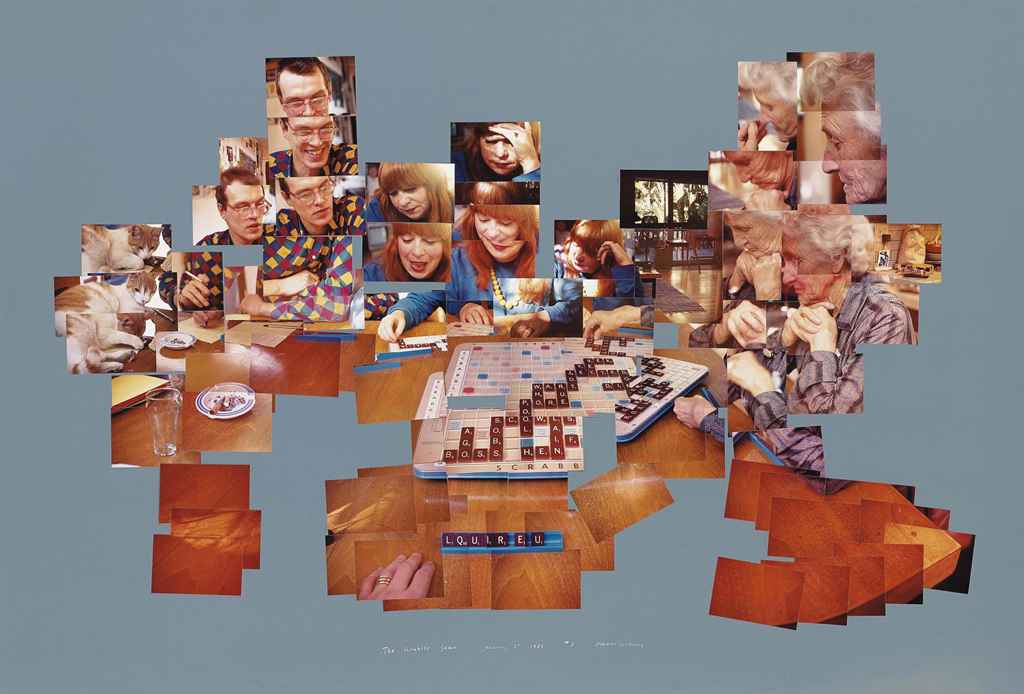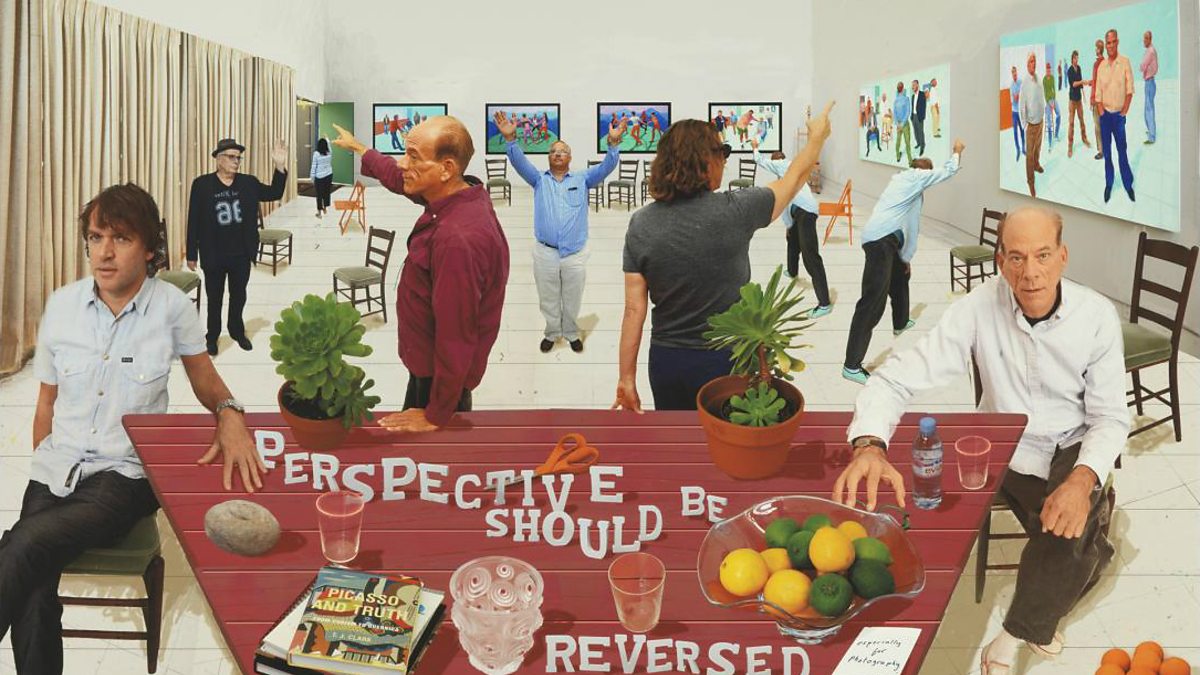Adding Pigment 2.0
From Londonhua WIKI
Contents
Monet
Claude Monet was a French artist of the Impressionist movement. This movement was named after one of his paintings called Impression, Sunrise. This is because you can only see an impression of the sunrise and the person in it because he changed a lot his subjects and how he depicted them. [1]The the viewer has to analyzed, assume and connect the dots to figure out the painting. This is not exactly abstract art but it is definitely different from traditional art at that time. Monet had many artists as inspiration and started with no knowledge of art. He became to be known one of the best-known artists in the world. His purpose was to overcome tradition and use intense brushstrokes to create an impression of a painting. He started painting in Paris and many scenes of the Seine river. He painted impressions of landscapes of the place he lived in at different times of the day. We can clearly see this in one of his biggest collection of paintings Water Lilies that he painted when he was living in Givenchy. Monet moved a lot during his life mainly within France, however, during the Franco-Prussian War, he moved to London for two years. [2]
During his time in London, he painted many of its landscapes and buildings at different times of the day as he was known for. He painted many views from the Thames including Parliament and Westminster. His short stay in London resulted in the largest series of paintings that he had yet produced. [3] Monet, as many artists admired the London fog. As Christine Corton said in her book London Fog in page 184 Monet commented " Without the fog, London wouldn't be a beautiful city... It's the fog that gives it it's magnificent breadth". I believe that he was intrigued by the fog as it went alongside this style. The fog was not traditional to him as he never saw it before in any French city. He portraits the fog as part of the landscape or the impression of the landscape which also gave him originality.
The pigment Monet added was his originality and how even though he painted the same thing many times, each painting was unique. He worried a lot about the ever-changing environment and the effects of light in his paintings. [4]Even though it was the same landscape you feel it it was a completely different environment. He focused a lot on the effects of light of the painting and used a distinct color palette for each painting. This different use of light add color provided him the irrefutable fame he currently has.
Through his life he wrote various letters when he was painting away from home. Letters that gave insights into his work.
Water Lilies at Tate Modern
Christopher Wren
"Christopher Wren (1632-1723) was the greatest architect Britain has ever known" [5] London and its skyline wouldn't be as we know them nowadays if it wasn't for Cristopher Wren. After the Great Fire of London, he was appointed to reconstruct many churches. St Paul was his biggest work with his design of the dome.
as scientist
[6]
As Lisa Jardine said in her book about Wren called On a grander scale: The outstanding life of Sir Christopher Wren, Wren was a versatile genius who could have pursued a number of brilliant careers with equal virtuosity. A mathematical prodigy, an accomplished astronomer, a skillful anatomist, and a founder of the Royal Society", Wren was a genius. He started his career as a scientist graduated from Oxford University. His most intimate friends were scientists. His connection to the Royal Society brought him into personal touch the King. [7]
as architect
as a whole
, he eventually made a career in what he described disparagingly in later life as "Rubbish" - architecture, and the design and construction of public buildings. Wren was a major figure at a turning point in English history. He mapped moons and the trajectories of comets for kings; lived and worked under six monarchs; pursued astronomy and medicine during two civil wars; exercised his creativity through the English Commonwealth, the Great Fire, the Restoration. His royal employment outlasted abdication, Dutch invasion, and the eventual extinction of the Stuart dynasty. Beyond the public achievements, Jardine explores Wren's personal motivations and passions. He was a sincere, intensely moral man with a remarkable capacity for friendship. His career was shaped by lasting associations forged during a turbulent boyhood and a lifelong loyalty to the memory of his father's master and benefactor, the "martyred king," Charles I. Everything Wren undertook, he envisaged on a grander scale - bigger, better, more enduring than anything that had gone before"
Trash
Monet
Oscar-Claude Monet (14 November 1840 – 5 December 1926) was a founder of French Impressionist painting, and the most consistent and prolific practitioner of the movement's philosophy of expressing one's perceptions before nature, especially as applied to plein-air landscape painting. The term "Impressionism" is derived from the title of his painting Impression, soleil levant (Impression, Sunrise), which was exhibited in 1874 in the first of the independent exhibitions mounted by Monet and his associates as an alternative to the Salon de Paris.Claude Monet's paintings are among the most well known and the widely enjoyed works of art in the world. His pictures of the French landscape in radiant sunshine have captured the imagination of our age, and have often been taken to exemplify the twentieth century's favorite a movement, Impressionism. It has also been frequently assumed that such sun-filled canvases were produced by an equally sunny and artist, and Monet himself has not been subjected to same scrutiny as some of his more troubled contemporaries. During much of his lifetime Monet encourage this tendency, insisting on his right to privacy and refusing to indulge in theoretical speculations about his art. [8] He presented himself in many different guises through his long career and he had many changing opinions and feelings. For example, he was a really loyal friend but he could be very selfish at times and he could be a very conversationalist at times but other times he could be truculent. His art was affected by all this and his moods. Monet’s life revolved around his art.
Monet was born in Paris in 1840 in a region of 'good' Louis -Philippe, in an environment entirely dedicated to commerce. [9]. At a very young age his family moved to Le Havre. His mother died a few years after they moved. He was undisciplined and never followed the rules. He changed until he was fourteen when his art began. He drew flower in the margins of his papers and drew caricatures of his professors. He became famous all over Le Havre as a caricaturist. He was introduced to a low repute artist back then called Bouldin. He studied with him, analyzing forms and colors. He decided to become a painter. Monet wanted to go back to Paris to pursue his passion for art and his aunt Marie-Jeanne Lecadre helped him. He had an allowance with the condition to study art. He had a gregarious youth leading the Bohemian life in Paris. However, because of his behavior his family withdrew any financial aid. He went into military service to Algeria. He mentions how this changed his life. He saw the impression of light different after this service. He returned to Paris where he meet Camille Doncieux and in 1867 they had their first son together. He was penniless so went back to Le Havre with his new family. It was not easy but they found a home and got married. They had their weeding in Paris in summer of 1870, but that autumn the Franco-Prussian War and the treat of conscription persuaded them to flee to coastal resort of Trouville. later on they took refugee in London. They returned to France though Holland and moved around the county. Many of this locations where near the Seine River. Camille had a second child and shortly died. He was now in the company of Alice Hoschede. In 1883 Alice and her six children and Monet and his two children moved to Giverny, a small village overlooking water near the Seine. He purchased a house and property and began a vast landscaping project which included lily ponds that would become the subjects of his best-known works.He was a patriarch of his family. Later in his life, he preferred to have privacy in the gardens at Giverny where he found freedom. [10]
- His short stay in London resulted in the largest series of paintings that he had yet produced.
Tate Modern 1916
Wren
Christopher Wren (1632-1723) was the greatest architect Britain has ever known [11]
Christopher Wren was born in 1632 in East Knoyle, in the most tranquil years of the reign of Charles I. His family had close contact with the court, for though at the time of his birth his father was Rector of East Knoyle, Wiltshire, were he was born. [12]
he was very soon to succeed his brother Matthew as Dean of Windsor and Registrar of the Order of the Garter. Both brothers, Royalist and High Church, were to suffer for their opinions during the Civil War. His father later moved to Windsor and Wren was educated at Westminster School and then Oxford University. He showed an early talent for mathematics and enjoyed inventing things, including an instrument for writing in the dark and a pneumatic machine. In 1657, Wren was appointed professor of astronomy at Gresham College in London and four years later, professor of astronomy at Oxford. In 1662, he was one of the founding members of the Royal Society, along with other mathematicians, scientists and scholars. Wren’s scientific work raged over a variety of fields including astronomy, meteorology, physiology and the laws of motion. He was an active member of the Royal Society for many years after he had left science for architecture. His most intimate friends were scientists. His connection to the Royal Society brought him into personal touch the King. [13]
English architecture at the time Wren began to build was in a somewhat confused state, and there was no clearly recognizable style. Wren made himself into a great architect. He had no formal training and little opportunity of knowing, at first-hand, the architecture of the Continent of his own or any other age. He built nothing before he was thirty. However, his buildings were revolutionary to the English. He was influenced by many architects at that time. Perhaps the most striking, and certainly the most influencial, was the new Banqueting House for Whitehall Palace of 1619-21. [14] The used related proportions in every part of the building and the regularity and sobriety of the window design and the restrained used of decorative detail was greatly admired by Wren. It is not clear precisely why Wren first turned to architecture, but ir well have been that, since he was known as a gifted mathematician with strongly practical turn of mind. [15]
The Great Fire of 1666 devastated the centre of London, with a loss of old St Paul's and eighty-six parish churches. Sir Christopher Wren, working with Commissioners appointed by Parliament, was responsible for rebuilding the cathedral and fifty-one of the parish churches, although the immediate need to start rebuilding made his design for an overall replanning of the City impossible. The work was funded by a tax on coals brought into the City of London. He was presented with remark for was called upon to design a great number of buildings widely differing in and intention; and by a process of trial and error, and above all of retrial, he learnt from his opportunities until he became a master of his art. One of his outstanding characteristics throughout his life was indeed his willingness to produce a scheme, to abandon it if it proved impractical, and to go on working on a problem, often even during execution until something both satisfactory and possible had been achieved. His work cannot, in fact, be fully appreciated without some reference to discarded schemes, for it is here that the striking flexibility of his mind is best displayed. It enabled him to achieve a great range of buildings one less magnificent than he might have wished, but supremely well suited to their purpose and to the circumstances which controlled their execution.
Wren's personal motivations and passions included a sincere, intensely moral man with a remarkable capacity for friendship, his career was shaped by lasting associations forged during a turbulent boyhood, and a lifelong loyalty to the memory of his father's master and benefactor, the "martyred' king, Charles I. Everything Wren undertook he envisaged on a grander scale bigger, better, more enduring than anything that had gone before. [16]
He mapped moons and the trajectories of comets for kings; lived and worked under six monarchs; pursued astronomy and medicine during two civil wars; exercised his creativity through the English Commonwealth, the Great Fire and the Restoration. His royal employment outlasted abdication, Dutch invasion, and the eventual extinction of the Stuart dynasty., he eventually made a career in architecture, and the design and construction of public buildings. he mapped the moon and the stars, investigated the problem of longitude and the rigns of Saturn, and carried out groundbreaking experiments into the circulation of the blood. His observetions on coments, meteorology and muscular action made vital contributions to the developing ideas of Newton, Halley and Boyle. He remained, nonetheless, committed to the practice of science, several of his buildings reflect the diversity of his interests. The Monument to the Great Fire was built with a subterranean laboratory; the south west tower of St Paul's was used as a vertical telescope during construction both were designed to function simultaneously as public monuments and as oversize scientific instruments. [17]
- From 1689 - 1700, Wren worked at Hampton Court Palace and amongst other projects, re-built the south front of Hampton Court and designed the pews, the panelling and the pillars supporting the Royal pew in The Chapel Royal.
-
- Wren was a major figure at a turning point in English history. A mathematical prodigy, an accomplished astronomer, a skillful anatomist, and a founder of the Royal Society The man behind the work was as remarkable as the monuments he has left us.
Avant Garde
You have to analyze the painting and interpret what Monet wanted to express. This exactly what Monet and most Impressionists wanted, to
Documentary
Origin
The poetic mode began in tandem with modernism as a way of representing reality in terms of a series of fragments, subjective impressions, incoherent acts, and loose associations.These qualities were often attributed to the transformations of industrialization generally and the effects of World War I in particular. The modernist event no longer seemed to make sense in traditional narrative, realist terms. Breaking up time and space into multiple perspectives, denying coherence to personalities vulnerable to eruptions from the unconscious, and refusing to provide solutions to insurmountable problems had the sense of an honesty about it even as it created works of art that were puzzling or ambiguous in their effect. Although some films explored more classical conceptions of the poetic as a source of order, wholeness, and unity, this stress on fragmentation and ambiguity remains a prominent feature in many poetic documentaries. The historical footage, freeze frames, slow motion, tinted images, selective moments of color, occasional titles to identify time and place, voices that recite diary entries, and haunting music build a tone and mood far more than they explain the war or describe its course of action.
Artists from the present
In more contemporary times, leaving behind the dense, yellow and deadly fog as an everyday scene, London is a setting that enraptures less mystery and more and more magic. More color and a wider variety of emotions are displayed in all forms of art.
J.K. Rowling
 |
Joanne Rowling was born on 31st July 1965, she is the creator of the most famous and best-loved novel series in contemporary fiction. [18] Joanne or better known as J.K.Rowling (The “K” stands for Kathleen, her paternal grandmother’s name) grew up in Gloucestershire in England and in Chepstow, Gwent, in southeast Wales. The young Jo grew up surrounded by books. “I lived for books,’’ she has said. “I was your basic common-or-garden bookworm, complete with freckles and National Health spectacles.” Jo wanted to be a writer from an early age. She wrote her first book at the age of six – a story about a rabbit, called ‘Rabbit’. At just eleven, she wrote her first novel – about seven cursed diamonds and the people who owned them. [19]
Jo left home at eighteen for Exeter University. After her degree, she moved to London and worked in a series of jobs, including one as a researcher at Amnesty International. [20] Here in London conceived the idea of Harry Potter while sitting on a delayed train from Manchester to London King’s Cross in 1990. Over the next five years, she began to map out all seven books of the series. She wrote mostly in longhand and gradually built up a mass of notes, many of which were scribbled on odd scraps of paper. Taking her notes with her, she moved to northern Portugal to teach English as a foreign language, married Jorge Arantes in October 1992 and had a daughter, Jessica, in 1993. When the marriage ended later that year, she returned to the UK to live in Edinburgh, carrying not just Jessica but a suitcase containing the first three chapters of Harry Potter and the Philosopher’s Stone. In Edinburgh, Jo trained as a teacher and began teaching in the city’s schools, but she continued to write in every spare moment. [21]
Having completed the full manuscript, she sent the first three chapters to a number of literary agents, one of whom wrote back asking to see the rest of it. She says it was “the best letter I had ever received in my life.” The book was first published by Bloomsbury Children’s Books in June 1997, under the name J.K. Rowling. It was added at her publisher’s request, who thought a book by an obviously female author might not appeal to the target audience of young boys. Her first novel was published in the US under a different title, Harry Potter and the Sorcerer’s Stone, in 1998. Six further titles followed in the Harry Potter series, each achieving record-breaking success.In 2001, the film adaptation of the first book was released by Warner Bros., and was followed by six more book adaptations, concluding with the release of the eighth film, Harry Potter and the Deathly Hallows Part 2, in 2011. In 2012, J.K. Rowling published her first novel for adults, The Casual Vacancy (Little, Brown), which has now been translated into 44 languages and was adapted for TV by the BBC in 2015. [22]
As an OBE (Order of the British Empire) and FRSL (Royal Society of Literature), Jo, is the United Kingdom's best-selling living author, with sales in excess of £238M. [23] She is listed as the second-richest woman in entertainment (behind Oprah Winfrey) in a 2007 Forbes list, with estimated earnings of $1 billion. However, she is also a very charitable person. In 2000, Rowling established the Volant Charitable Trust, which uses its annual budget of £5.1 million to combat poverty and social inequality. The fund also gives to organisations that aid children, one parent families, and multiple sclerosis research. [24]
In her mirrored figures Remus Lupin and Fenrir Greyback, J. K. Rowling has presented one of the most complete manifestations of the shape-shifter archetype in modern fiction. Fittingly, she places one half of the manifestation overtly in the role of an educator, perhaps the first werewolf openly filling a teacher's position in Western literature. Both halves work together to move beyond classical, Renaissance, and early twentieth-century film's representation of the werewolf as a monstrous, cannibalistic beast to present the figure as an educator on several layers. In doing so, Rowling returns to and builds upon medieval conceptions of the werewolf and archetypal functions of the shape-shifter and shadow. The purpose of this paper is to explore exactly how she employs the werewolf as a manifestation of the shape-shifter archetype and as a tool for educating both her characters and readers. [25]
KING'S CROSS
A busy and crowded station. Full of people trying to go somewhere. Amongst the hustle and bustle, two large cages rattle on top oftwo laden trolleys.
PLATFORM NINE AND THREE-QUARTERS
And which is also busy, but instead of people in sharp suits going about their day, it's now wizards and witches in robes mostly trying to work out how to say good-bye to their beloved project. [26]
Harry Potter series
- Harry Potter and the Philosopher's Stone (26 June 1997)
- Harry Potter and the Chamber of Secrets (2 July 1998)
- Harry Potter and the Prisoner of Azkaban (8 July 1999)
- Harry Potter and the Goblet of Fire (8 July 2000)
- Harry Potter and the Order of the Phoenix (21 June 2003)
- Harry Potter and the Half-Blood Prince (16 July 2005)
- Harry Potter and the Deathly Hallows (21 July 2007)
Related works
- Fantastic Beasts and Where to Find Them (supplement to the Harry Potter series) (1 March 2001)
- Quidditch Through the Ages (supplement to the Harry Potter series) (1 March 2001)
- The Tales of Beedle the Bard (supplement to the Harry Potter series) (4 December 2008)
- Harry Potter and the Cursed Child (story concept) (31 July 2016)
- Short Stories from Hogwarts of Power, Politics and Pesky Poltergeists(6 September 2016)
- Short Stories from Hogwarts of Heroism, Hardship and Dangerous Hobbies (6 September 2016)
- Hogwarts: An Incomplete and Unreliable Guide (6 September 2016)
- Fantastic Beasts and Where to Find Them (film)|Fantastic Beasts and Where to Find Them (film script) (19 November 2016)
Adults
- The Casual Vacancy (27 September 2012)
- The Cuckoo's Calling (as Robert Galbraith) (18 April 2013)
- The Silkworm (as Robert Galbraith) (19 June 2014)
- Career of Evil (as Robert Galbraith) (20 October 2015)
David Hockney
 |
David Hockney is an English painter, printmaker, stage designer and photographer and one of the most important figures in modern art. He was born on July 9th 1937 in the center of England's wool trade, with a population of 300,000; the city of Bradford in West Yorkshire. The city had been immortalized as "Bruddersford"in the popular imagination of J. B. Priestley in his best-selling novels "The Good Companions" and "Bright Day". In the last one he wrote, "Bruddersford is generally held to be an ugly city; and so I suppose it is; but it always seemed to me to have the kind of ugliness that could not only be tolerated but often enjoyed". [27] And the thing was that Bradford was immersed in the damp smog of those years "for the two hundred or so chimneys of the woollen mills were belching out fumes all day, which sank slowly into the basin in which the city lies, and made Bradford then one of the smokiest cities on earth".[28]. Since Hockney was 10 years old he knew he wanted to be an artist and he used to enter painting and drawing competitions for children that used to appear regularly in the Daily Express. His parents always encouraged him with his love for art and he would always appeared to be the most cheerful of his other four siblings. He was also very inspired by his English teacher Kenneth Grose, who recognized that, in spite of his inability to work hard in anything but art, he was full of curiosity "He was a stimulant and he encouraged me in my ambitions to be an artist". [29]
Hockney attended the Bradford College of Art from 1953 to 1957. Then, because he was a conscientious objector to military service, he spent two years working in hospitals to fulfill his national service requirement. In 1959, he entered graduate school at the Royal College of Art in London where he experimented with different forms, including abstract expressionism. He did well as a student, and his paintings won prizes and were purchased for private collections. Hockney’s early paintings incorporated his literary leanings, and he used fragments of poems and quotations from Walt Whitman in his work. This practice, and paintings such as We Two Boys Clinging Together, which he created in 1961, were the first nods to his homosexuality in his art. Because he frequently went to the movies with his father as a child, Hockney once quipped that he was raised in both Bradford and Hollywood. He was drawn to the light and the heat of California, and first visited Los Angeles in 1963. The swimming pools of L.A. were one of his favorite subjects, and he became known for large, iconic works such as A Bigger Splash. [30] In December of 1964, Hockney returned to London to give a talk on homosexual imagery in America. A year later, he returned to America to teach at the University of Colorado in Boulder. There he lived in an apartment without windows and painted the Rocky Mountains from his memory. After his term there, Hockney went to California with some old friends. Two years later, Hockney experienced his first true romance with a nineteen-year-old student named Peter Schlesinger. Schlesinger became a favorite subject of Hockney's, and the many drawings of him show the informal intimacy of the two. A year later, Schlesinger transferred to Los Angeles from Santa Cruz and moved into an apartment with Hockney, which made him very happy. In June of 1967, Hockney took him to Europe, and the two toured the continent. At this time, Hockney's interest in photography grew. He would take endless shots of Schlesinger, mostly for fun, but also for study. In 1971, Hockney experienced some tension in his relationship with Schlesinger mostly because of the age difference between the two. Also, Schlesinger wanted some independence and room to grow so Hockney's eye also began to wander, and his social life became more active once again. Hockney decided to travel to America for a break, and when he returned, he found out that Schlesinger had moved to Paris and had been having an affair. Schlesinger felt that Hockney placed his work above everything else and felt as though he himself were only an erotic object to be shown off to others so he decided never to move back in with Hockney again. Hockney was devastated and started taking Valium to combat the depression and loneliness he suffered, however continued to excel in his work, embracing the emerging technologies. By the mid 1970s, he had all but abandoned painting in favor of projects involving photography, lithographs, and set and costume design for the ballet, opera and theater. [31]
Basic to David Hockney's art has always been the need to communicate directly with the viewer. Hockney is not at all involved in the creation of beauty as an end in itself. It is exactly this didactic urgency, this need to be heard plainly and to be understood clearly, which is the basis of his phenomenal popularity. No other artist today has been the subject of so many books, most of them generated by the prodigious flow of his own art, work that he produces in abundance and with great care. [32]Hockney is widely known for his adaptability and his ability to create new techniques using the emerging technologies. In photography, specifically he turned to “recreate photography” in a way in which, as he said, “a photograph that could be described as having a strong illusion of reality”. In the second volume of his biography written by Christopher Simon Skyes, he explains that in a point of his life, he started to feel that photography was missing something, and so he decided to add his personal touch to it, starting to do picture collages. “The main aspect was this lack of time in the photograph. I'd become very, very aware of this frozen moment, that was very unreal to me. Photography didn't really have life in the way a drawing or painting did, and I realized it couldn’t because of what it is. compared to Rembrandt looking at himself for hours and hours and scrutinising his face, and putting all these hours into the picture you're going to look at, naturally there's many more hours there than you can give it. A photograph is the other way round. It's the fraction of a second, frozen, so the moment you looked at it for even four seconds, you've looked at it for longer than the camera did. It dawned on me that this was visible, actually, and the more you become aware of it, the more this is a terrible weakness. Drawings and paintings do not have this." [33]
In the nineties, Hockney continued to experiment with rising technologies. He used a color laser copier in some of his works and reproduced some of his paintings. Hockney was impressed with the vibrancy of color that could be achieved using such devices. He also began sending drawings to friends via fax machines and was thrilled with this new way of communication. Much of the appeal lay in the fact that these newly produced images had no financial value at all. Thus sharing art became a true act of love and appreciation. Though Hockney does not have a great number of photographies of London itself, he has been one of the most influential and innovative British artists for the past half a century. He developed a way to give a story to his images, instead of just leaving them as a single photograph. Through his collages, he adds identity to his characters and is able to transmit emotions and ideas, creating a reality for each one and showing it to its viewers. He has truly made art a form of real human interaction and communication. His photography comes to life as he pushes the boundaries of figurative art and inspires many other creators as himself. In a 2011 poll of more than 1,000 British artists, Hockney was voted the most influential British artist of all time. He continues to paint and exhibit, and advocates for funding for the arts. [34]
Ken Shuttleworth
 |
Ken the Pen
"He is one of the best hidden talents in the UK," says Stuart Lipton, the chairman of the government's architecture watchdog, Cabe (Commission for Architecture and the Built Environment).
[35]
Ken Shuttleworth is an English architect. He is the designer of distinctive designs as City Hall, the new Greater London Authority headquarters beside Tower Bridge, the arches of the future Wembley Stadium, Hong Kong's Chek Lap Kok airport, and the Commerzbank, Frankfurt. Shuttleworth studied architecture at the Leicester School of Architecture, De Montfort University. He was there known as a very skilled at designing, he acquires the nickname "Ken the Pen". He drew twice as fast as anyone else, his fluid draftsmanship was unique back then and it is still now.
He says he became interested in architecture when he was four or five years old, when he began furiously sketching houses and castles. His father, an accountant, encouraged him: "He hated being an accountant. He said, 'Whatever you do, you should really enjoy doing it'." [36]
As an avant-garde designer, he has now a 130-strong practice with a global portfolio of multi-million pound commissions. His buildings, however, are extraordinary, although there is usually a perfectly sensible reason for their avant-garde forms. Wembley's giant arch creates a new landmark to replace the twin towers, but also provides a strong structure from which the stadium's roof can be hung. The sensational ramp that spirals up inside City Hall was born of a desire to allow equal access to the building: "I was very keen to make it so you could go all the way up in a wheelchair."
Often, the inspiration is environmental. The south-leaning egg shape of City Hall admits maximum indirect light into the building but minimises direct sunshine, thereby reducing the need for air-conditioning. Likewise, the twisting structure of the St Mary Axe tower reflects the naturally ventilated public gardens that spiral up the inside of the building. [37]
Shuttleworth became a partner at Foster and Partners where he worked on some of the world's most iconic buildings. With a staff of nearly 600 and over 100 projects on the computer screens, Foster and Partners is one of the world's busiest and highest-profile architectural practices. [38] He joined the practice in 1977, moving to Hong Kong in 1979 to oversee the design and construction of The Hongkong and Shanghai Banking Corporation’s headquarters. Returning to the UK in 1986, he proceeded to build up a remarkable portfolio.
At the age of 50, he has worked for Norman Foster for 28 years. He decided to leave the firm.
- ↑ House, J. (1988). Nature into art. New Haven: Yale University Press.
- ↑ Monet, C., & Kendall, R. (2003). Monet by Himself: paintings, drawings, pastels, letters. Boston: Little, Brown, Chapter 1.
- ↑ CORTON, C. L. (2015). LONDON FOG: the biography. S.l.: BELKNAP HARVARD. pp 182.
- ↑ House, J. (1988). Nature into art. New Haven: Yale University Press.
- ↑ Tinniswood, A., & Graham, N. (2005). His invention so fertile: a life of Christopher Wren. London: Royal National Institute of the Blind.
- ↑ Jardine, L. (2004). On a grander scale: the outstanding life and tumultuous times of Sir Christopher Wren. New York, NY: Perennial.
- ↑ Whinney, M. (1971). Wren. London: Thames & Hudson.
- ↑ Monet, C., & Kendall, R. (2003). Monet by himself: paintings, drawings, pastels, letters. Boston: Little, Brown..
- ↑ Denvir, B.(1987). The Impressionists at First Hand: Thames and Hudson.
- ↑ http://www.tate.org.uk/art/artists/claude-monet-1652
- ↑ Tinniswood, A., & Graham, N. (2005). His invention so fertile: a life of Christopher Wren. London: Royal National Institute of the Blind.
- ↑ History: Historical Figures. (n.d.). Retrieved June 06, 2017, from http://www.bbc.co.uk/history/historic_figures/wren_christopher.shtml
- ↑ Wren o Whinney
- ↑ Wren o Whinney
- ↑ Wren o Whinney
- ↑ Jardine, L. (2004). On a grander scale: the outstanding life and tumultuous times of Sir Christopher Wren. New York, NY: Perennial.
- ↑ Jardine, L. (2004). On a grander scale: the outstanding life and tumultuous times of Sir Christopher Wren. New York, NY: Perennial.
- ↑ Smith, S., & Carrington, N. (2005). J K Rowling: a biography. London: Royal National Institute of the Blind.
- ↑ J.K. Rowling. (n.d.). Retrieved June 15, 2017, from https://www.jkrowling.com/about/
- ↑ J.K. Rowling. (n.d.). Retrieved June 15, 2017, from https://www.jkrowling.com/about/
- ↑ J.K. Rowling. (n.d.). Retrieved June 15, 2017, from https://www.jkrowling.com/about/
- ↑ J.K. Rowling. (n.d.). Retrieved June 15, 2017, from https://www.jkrowling.com/about/
- ↑ Farr, E. (2012, October 03). JK Rowling: Casual Vacancy tops fiction charts. Retrieved June 15, 2017, from http://www.telegraph.co.uk/culture/books/booknews/9584404/JK-Rowling-Casual-Vacancy-tops-fiction-charts.html
- ↑ Memmott, C. (2007, July 26). Retrieved June 15, 2017, from https://usatoday30.usatoday.com/life/books/news/2007-07-25-jk-rowling_N.htm
- ↑ Stypczynski, B. (2009). Wolf in Professor's Clothing: J. K. Rowling's Werewolf as Educator. Journal of the Fantastic in the Arts, 20(1 (75)), 57-69. Retrieved from http://www.jstor.org/stable/24352314
- ↑ Thorne, J., Rowling, J. K., & Tiffany, J. (2016). Harry Potter and the cursed child: parts one and two. London: Little, Brown.
- ↑ Bright Day, J. B. Priestley, Heinemann 1946
- ↑ Sykes, C. S. (2011). Hockney: The Biography (Vol. 1). London: Century, pp. 1-25
- ↑ Interview with David Hockney by Christopher Simon Skyes, June 2009
- ↑ David Hockney. (2014, April 02). Retrieved June 05, 2017, from https://www.biography.com/people/david-hockney-9340738
- ↑ David Hockney Biography. (n.d.). Retrieved June 05, 2017, from http://www.davidhockney.com/bio.shtml
- ↑ Tuchman, M., & Barron, S. (1989). David Hockney: a retrospective. Los Angeles, CA: Los Angeles County Museum of Art, pp. 13
- ↑ Sykes, C. S. (2014). Hockney: The Biography (Vol. 2). London: Century, pp. 160
- ↑ David Hockney. (2014, April 02). Retrieved June 05, 2017, from https://www.biography.com/people/david-hockney-9340738
- ↑ Fairs, M. (2003, January 22). Ken Shuttleworth: architecture's best-kept secret. Retrieved June 15, 2017, from https://www.theguardian.com/artanddesign/2003/jan/22/architecture.artsfeatures
- ↑ Fairs, M. (2003, January 22). Ken Shuttleworth: architecture's best-kept secret. Retrieved June 15, 2017, from https://www.theguardian.com/artanddesign/2003/jan/22/architecture.artsfeatures
- ↑ Fairs, M. (2003, January 22). Ken Shuttleworth: architecture's best-kept secret. Retrieved June 15, 2017, from https://www.theguardian.com/artanddesign/2003/jan/22/architecture.artsfeatures
- ↑ Glancey, J. (2003, November 27). Controversial architect Ken the Pen has designs on new projects. Retrieved June 15, 2017, from https://www.theguardian.com/uk/2003/nov/27/arts.artsnews2
